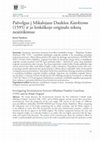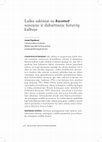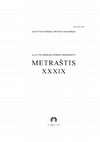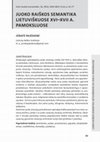Papers by Jurate Pajediene

Vertimo studijos, 2018
Straipsnyje aptariamas pirmosios lietuviškos katalikiškos knygos - Mikalojaus Daukšos Katekizmo (... more Straipsnyje aptariamas pirmosios lietuviškos katalikiškos knygos - Mikalojaus Daukšos Katekizmo (DK, 1595) - neatitikimų lenkiškajam originalui pobūdis ir šių neatitikimų atsiradimą nulėmusios priežastys. Teksto kilmės požiūriu DK sudaro du skirtingų autorių kūriniai: KATHECHIS MAS ir Trumpas Budas Paſiſákimo. Lyginant lietuviškus šio konvoliuto knygų tekstus su lenkiškuoju originalu nesunku pastebėti, kad DK (ypač pirmojoje dalyje - Kathechisme) esama daug lenkiškojo originalo neatitinkančių teksto intarpų. Šių tekstų sugretinimo analizė leidžia Daukšą apibūdinti kaip autorių, kuriam buvo labai svarbi diskurso logika, tvarka ir skambesys. Neatitikimų visuma rodo vertėjo pastangas pateikti skaitytojui kuo suprantamesnį ir rišlesnį tekstą ir atskleidžia atidų vertėjo požiūrį į teologinių nuostatų formuluotes. Ypač įdomi Kathechisme pateikiamų Dekalogo prisakymų atitikimų ir neatitikimų lenkiškojo originalo modeliui sankloda. Sugretinus nuo lenkiškojo originalo leksinėmis detalėmis ar ištisomis frazėmis besiskiriančias DK Dekalogo prisakymų formuluotes su Mažvydo (1547) bei Vilento (1579) parengtuose katekizmuose esančiomis atsiskleidžia pagalbinis pastarųjų šaltinių vaidmuo ir pamatinių tikybinių frazių formulavimo perimamumas.

Vilnius University Proceedings Nr. 1 (2018): Baltų kalbų tekstų ir žodžių reikšmės , 2018
The article discusses the usage of subordinate clauses of time with kuomet in Old Lithuanian and ... more The article discusses the usage of subordinate clauses of time with kuomet in Old Lithuanian and Modern Lithuanian. The morphosyntactic structure of time clauses with kuomet recorded in old Lithuanian writings (both translations and original texts) is rather similar: they are usually employed to emphasize the exceptionality of a certain moment or situation; therefore, they use negatives or other syntactic means highlighting exceptionality rather frequently, whereas time clauses with kuomet become an important part of the argumentative discourse. Situational, semantic and positional models of time clauses containing kuomet show that kuomet used in the time clauses of old Lithuanian writings meets all the necessary parameters of adverbial subordinator. The usage of time clauses with kuomet in the original works of the authors of the old writings attributed to different dialects – Jonas Bretkūnas, Zacharijus Blothnas and Konstantinas Sirvydas – prevents us from considering kuomet to be a dialecticism. The time clauses with kuomet used in Modern Lithuanian are also used to describe the situations of two actions which are related to exceptionality and the importance of a special moment. It enables us to define kuomet as a traditionally inherited adverbial subordinator of time clauses and to stop doubting the grammatical and contextual suitability of this subtype of time clauses for Modern Lithuanian.

Baltu filoloģija 27(1/2), 2018
The article discusses the structural and morphosyntactic peculiarities of subordinate clauses of ... more The article discusses the structural and morphosyntactic peculiarities of subordinate clauses of time used in two collections of texts representing the speech of the users of the Northern Samogitian subdialect of Telšiškiai in the 1960s–1980s: Taip šneka tirkšliškiai (TŠT) and Šiaurės
žemaičiai telšiškiai (ŠŽT). The above texts in the Northern Samogitian subdialect of Telšiškiai are not only interesting for the morphosemantic and syntactic peculiarities of adverbial clauses of time used in them but also for the different type of conversations that are recorded in them:
authentic speaking in the natural daily environment (the conversations used in TŠT were recorded secretly) and the speaking when the users of the subdialect are interviewed by an outsider (the authors of the texts used in ŠŽT knew that the conversation was recorded). Certain tendencies of the use of time clauses in TŠT and ŠŽT were determined by the different levels of naturalness of speaking and/or the respondents’ age. The most distinct differences of the time clauses
used in the texts of TŠT and ŠŽT are seen in the choice of the narrative time line: the natural dialogues recorded in TŠT demonstrate a less prominent direction of the narrative passages expressed by time clauses towards the past and a far more common orientation of themes towards
the present and the future.
The time clauses denoting habitual action with their predicates expressed by the verbs in the future tense (without the auxiliary verb lub(o)) are frequently used in both TŠT and ŠŽT. The use of sentences of this grammatical model show the imperfective nature of the situations
considered habitual. The structure of the time clauses used in both collections of texts demonstrates a rather common shift of an adverbial subordinator from the marginal position starting the subordinate clause towards the centre of the sentence. Such subordinate clauses which start with subject, object, place or manner references rather than an adverbial modifier show the moment when the description of adverbial modifiers of time with another action is comprehended in natural speech acts.

Acta Linguistica Lithuanica 79, 2018
Samogitians are viewed differently: as stubborn, silent, sluggish, even impolite… But there is no... more Samogitians are viewed differently: as stubborn, silent, sluggish, even impolite… But there is nothing that can better show a person’s character than his/her language. Not only what a person says about him/herself and others but also how he/she says it. Not only from the perspective of politeness but also wording. The speaker may sometimes not even feel the exceptionality of his/her utterance. It is a bit easier to recognise it when it is frozen in writing. A number of gems of spoken Samogitian can be found in the Kretinga Dialect Dictionary by Juozas Aleksandravičius. Based on the data provided by this dictionary, the article attempts to show how the Samogitian attitude towards themselves and others, various stages of life, the surrounding environment and the possibility to be alone and to be together with others by trying to get along and to agree unfolds itself while speaking.

Bendrinė kalba, 2017
LITHUANIAN WRITTEN DISCOURSE: PARTICIPIAL PRONOUNS REFERRING TO ADDRESSEE
The article discusses t... more LITHUANIAN WRITTEN DISCOURSE: PARTICIPIAL PRONOUNS REFERRING TO ADDRESSEE
The article discusses the variations of spelling of participial pronouns referring to another person in the Lithuanian written discourse. Next to the usual spelling Tu/Jūs based on the traditional stylistic capitalization, the model of spelling where the pronoun referring to the addressee starts with a lower-case letter tu/jūs exists as well. The reference to a dialogue partner and the way it is presented are an essential communication detail; therefore, naturally, the likely reasons, directions and effects of the current tendencies of varying spelling of participial pronouns in direct discourses are linked with the conception of the category of PERSON itself.
The article reviews the models of perception of participial pronouns proposed in linguistic descriptions and discusses the levels of communication of ONE PERSON’S relationship to ANOTHER in which the interlocutors find themselves when using the forms of the same pronoun which are differently coded in writing. It is normal in the Lithuanian written tradition to add prominence to the person by capitalising the participial pronoun referring to the interlocutor. It is a way to show the attitude to ANOTHER PERSON based on mutual understanding.

BALTU FILOLOĢIJA, 2016
The article sets out to discuss peculiarities in the usage of subordinate clauses of time in the ... more The article sets out to discuss peculiarities in the usage of subordinate clauses of time in the translation of the New Testament by Jonas Bretkūnas (hereinafter – BNT). The study found that the time clauses with adverbial subordinators iki, net, pirm ne kaip/pirm nei, kolei/kalei, kaip, kada/kad, kuometu are used in both BNT and the sermons of Bretkūnas’ Postilla (BP, 1591). The BNT text records a single, yet very important, usage of the adverbial subordinators of time clauses kai and tuojau, which does not appear in BP. The structure of time clauses in BNT shows a rather consistent adherence to the sentence
model used in the main originals, Martin Luther’s NT translation and/or the Vulgate, with only occasional obvious attempts by Bretkūnas to find the best way to express the sentence with reference to the examples of sentences from auxiliary sources – the NT of the Polish Brest Bible and, possibly, the NT in Old Greek.
Martynui Mažvydui atminti: raštijos raida ir XXI amžiaus iššūkiai, 2014
Straipsnyje nagrinėjamas knygos Oeconomia (1546, Karaliaučius) eiliuotosios prakalbos kaip galim... more Straipsnyje nagrinėjamas knygos Oeconomia (1546, Karaliaučius) eiliuotosios prakalbos kaip galimo pavyzdinio modelio M. Mažvydo CATECHISMVSA PRAſty Sʒadei (1547, Karaliaučius) eiliuotajai prakalbai klausimas. Verčiamą J. Seklucjano Katechismy text prosti (1545, Karaliaučius) Mažvydas papildė krikščioniškos etikos pagrindus pateikiančiu Urėdų skyriumi. Vienas iš Urėdų teminį pobūdį atitinkančių kūrinių tuometinėje Mažvydo aplinkoje buvo J. Seklucjano parengta Oeconomia. Joje esančią J. S. prakalbą Argumentum albo summa tych książek ir Mažvydo prakalbą KNIGIELES Pacʒias byla Letuuinikump jr Sʒemaicʒiump sieja perteikiamų idėjų, sintaksinio eiliavimo ir pavadinimo modelio atitiktys.

Lietuvių katalikų mokslo akademijos Metraštis, 2016
The article discusses the reasons that determined the formation and establishment of temporal cla... more The article discusses the reasons that determined the formation and establishment of temporal clauses with kiek kartų in Old Lithuanian, the frequency of their use, morphosyntactic properties, semantics and synonymous equivalents. Temporal clauses containing the adverbial subordinator kiek kartų were used to provide information about the action that was expected to happen at an indefinite time and at an incidental or repetitive frequency. The dynamic desemanticization of the phrase word kiek kartų with the usual lexical meaning and its transformation into a word with special grammatical characteristics typical only of a functional word which occurred in Old Lithuanian can be associated with the performativity of certain phrases used by the Christian Church. The sentence models with temporal clauses containing kiek kartų, which express the lines
1 Cor 11, 25–26 and are used in the old Lithuanian texts, are linked with an important element of the Christian rituals – the Altar’s Sacrament or the Eucharist. To perform this ritual and to explain its importance, the temporal clauses with kiek kartų expressing the lines 1 Cor 11, 25–26 are not only found in old Lithuanian homilies, but also in catechisms.
Acta Linguistica Lithuanica, 2015
The article discusses the process of publishing of a three-volume Lithuanian grammar
by a famous... more The article discusses the process of publishing of a three-volume Lithuanian grammar
by a famous Polish linguist Jan Otrębski (1889-1971), the composition of grammatical description, its peculiarities and evaluations.
BALTU FILOLOĢIJA, 2015
The article provides the results of a comparative study of subordinate clauses of time with conju... more The article provides the results of a comparative study of subordinate clauses of time with conjunctions of the general meaning of time in pericopes of the texts of Wolfenbüttelʾs Postilla (WP, 1573), J. Bretkūnasʾ Postilla (BP, 1591), M. Daukšaʾs Postilla (DP, 1599), K. Sirvydasʾ Punktai sakymų (SP I – 1629, SP II – 1642) and the texts of B. Vilentas’ Gospels and Epistles (VEE, 1579) and J. Jaknavičiusʾ Gospels (JE, 1647). They are presented with a focus on lexical, grammatical and pragmatic peculiarities of expressing the same biblical verse by means of a temporal clause in different sources. The matching and diverging expressions of an identical verse in different sources enable a distinction of model sources of a foreign original and an earlier Lithuanian text.
Contributions to Morphology and Syntax. Proceedings of the 4th Greifswald University Conference on Baltic Languages. Edited by Artūras Judžentis & Stephan Kessler., 2015
This paper sets out to discuss features of negation
employed in complex sentences with subordinat... more This paper sets out to discuss features of negation
employed in complex sentences with subordinate clauses of
time in Old Lithuanian.
BALTU FILOLOĢIJA, 2014
The article gives an overview of the morphosyntactic structure and semantics of the subordinate c... more The article gives an overview of the morphosyntactic structure and semantics of the subordinate clauses of boundary in pericopes of the sermons in Old Lithuanian – in the texts of Wolfenbüttelʾ Postilla (1573), J. Bretkūnasʾ Postilla (1591), M. Daukšaʾs Postilla (1599), K. Sirvydasʾ
Punktai sakymų (I – 1629, II – 1642) and the texts of B. Vilentas’ gospels and Epistles (1579) and J. Jaknavičiusʾ Gospels (1642).

Inter-studia humanitatis, 2014
SANTRAUKA Straipsnyje apžvelgiama juoko situacijų raiška XVI–XVII a. lietuviškai išleistų pamoksl... more SANTRAUKA Straipsnyje apžvelgiama juoko situacijų raiška XVI–XVII a. lietuviškai išleistų pamokslų rinkiniuose. Jono Bretkūno, Mikalojaus Daukšos ir Konstano Sirvydo pamokslų tekstuose dažniausiai minimos su pranašumo juoku susijusios situacijos. Pranašumo juokas, kuris neišvengiamai aptariamas pasakojant Kristaus nukryžiavimo istoriją, aprašomas kaip ypatingas socialinis reiškinys, kuris yra parodomasis, teatrališkas, besijuokiantieji turi kiekybinį ir galios pranašumą prieš apjuokiamąjį. Tokio juoko priežastis yra apjuokiamojo kitoniškumas. Besijuokiantieji siekia savo juoką vizualizuoti, įgarsinti triukšmu ir žodžiais (pavyzdžiui, įvardydami pastebėtus kitokio mąstymo paradoksus). Pamoksluose pateikiami emociniai besijuokiančiųjų ir apjuokiamojo paveikslai. Daukšos Postilė pamokslų adresatą pažindina su profesionaliąja juoko kultūra – aiškindamas tam tikrų situacijų teatrališkumą Jakubas Wujekas savo religiniame diskurse pasitelkia komedijos ir juokdario sąvokas. Tyrimui pasirinktuose pamokslų rinkiniuose pateikiama įdomių aprašymų iš kasdienybės, kuri pilna juokų, džiugesio, šėliojimų, linksminančio kalbėjimo. Sisteminė juoko situacijų pamoksluose apžvalga leidžia pamatyti tuo metu vyravusį požiūrį į juoką ir su juoku susijusių situacijų vertinimą. Bretkūno, Daukšos ir Sirvydo pamokslų rinkinių populiarumas leidžia manyti, kad su juoku susijusių gyvenimo situacijų vertinimas turėjo būti girdimas ir paveikus.

Leksikografija ir leksikologija. Konstantino Sirvydo darbai ir jo epocha., 2013
A contrastive analysis of the Lithuanian and Polish texts in K. Sirvydas’ book of sermons Punktai... more A contrastive analysis of the Lithuanian and Polish texts in K. Sirvydas’ book of sermons Punktai sakymų (part I was published in 1629, part II – in 1644) has revealed sustained effort on the part of the author to follow the principle of translating word-for-word, as declared by the author in the preface to the book. Some inconsistencies that occur
between the Lithuanian and Polish versions are of two types: quantitative and qualitative. The quantitative mismatches are mostly concerned with the length of the same texts – they are longer in Lithuanian and shorted in Polish or vice versa. The differences might have been determined by the intentions of the author or his assistants, more or less importance attached to the same things and manifested in, for example, references
to the Holy Script, popular idiomatic expressions only inserted in one of the languages, synonyms, the impact of the Latin sentences quoted in the commentaries and the like.
In memoriam by Jurate Pajediene
Baltistica 53(2), 2018
In memoriam Adelė Valeckienė
Baltistica 53(2), 2018
In memoriam Vytautas Ambrazas-Dubindris










Uploads
Papers by Jurate Pajediene
žemaičiai telšiškiai (ŠŽT). The above texts in the Northern Samogitian subdialect of Telšiškiai are not only interesting for the morphosemantic and syntactic peculiarities of adverbial clauses of time used in them but also for the different type of conversations that are recorded in them:
authentic speaking in the natural daily environment (the conversations used in TŠT were recorded secretly) and the speaking when the users of the subdialect are interviewed by an outsider (the authors of the texts used in ŠŽT knew that the conversation was recorded). Certain tendencies of the use of time clauses in TŠT and ŠŽT were determined by the different levels of naturalness of speaking and/or the respondents’ age. The most distinct differences of the time clauses
used in the texts of TŠT and ŠŽT are seen in the choice of the narrative time line: the natural dialogues recorded in TŠT demonstrate a less prominent direction of the narrative passages expressed by time clauses towards the past and a far more common orientation of themes towards
the present and the future.
The time clauses denoting habitual action with their predicates expressed by the verbs in the future tense (without the auxiliary verb lub(o)) are frequently used in both TŠT and ŠŽT. The use of sentences of this grammatical model show the imperfective nature of the situations
considered habitual. The structure of the time clauses used in both collections of texts demonstrates a rather common shift of an adverbial subordinator from the marginal position starting the subordinate clause towards the centre of the sentence. Such subordinate clauses which start with subject, object, place or manner references rather than an adverbial modifier show the moment when the description of adverbial modifiers of time with another action is comprehended in natural speech acts.
The article discusses the variations of spelling of participial pronouns referring to another person in the Lithuanian written discourse. Next to the usual spelling Tu/Jūs based on the traditional stylistic capitalization, the model of spelling where the pronoun referring to the addressee starts with a lower-case letter tu/jūs exists as well. The reference to a dialogue partner and the way it is presented are an essential communication detail; therefore, naturally, the likely reasons, directions and effects of the current tendencies of varying spelling of participial pronouns in direct discourses are linked with the conception of the category of PERSON itself.
The article reviews the models of perception of participial pronouns proposed in linguistic descriptions and discusses the levels of communication of ONE PERSON’S relationship to ANOTHER in which the interlocutors find themselves when using the forms of the same pronoun which are differently coded in writing. It is normal in the Lithuanian written tradition to add prominence to the person by capitalising the participial pronoun referring to the interlocutor. It is a way to show the attitude to ANOTHER PERSON based on mutual understanding.
model used in the main originals, Martin Luther’s NT translation and/or the Vulgate, with only occasional obvious attempts by Bretkūnas to find the best way to express the sentence with reference to the examples of sentences from auxiliary sources – the NT of the Polish Brest Bible and, possibly, the NT in Old Greek.
1 Cor 11, 25–26 and are used in the old Lithuanian texts, are linked with an important element of the Christian rituals – the Altar’s Sacrament or the Eucharist. To perform this ritual and to explain its importance, the temporal clauses with kiek kartų expressing the lines 1 Cor 11, 25–26 are not only found in old Lithuanian homilies, but also in catechisms.
by a famous Polish linguist Jan Otrębski (1889-1971), the composition of grammatical description, its peculiarities and evaluations.
employed in complex sentences with subordinate clauses of
time in Old Lithuanian.
Punktai sakymų (I – 1629, II – 1642) and the texts of B. Vilentas’ gospels and Epistles (1579) and J. Jaknavičiusʾ Gospels (1642).
between the Lithuanian and Polish versions are of two types: quantitative and qualitative. The quantitative mismatches are mostly concerned with the length of the same texts – they are longer in Lithuanian and shorted in Polish or vice versa. The differences might have been determined by the intentions of the author or his assistants, more or less importance attached to the same things and manifested in, for example, references
to the Holy Script, popular idiomatic expressions only inserted in one of the languages, synonyms, the impact of the Latin sentences quoted in the commentaries and the like.
In memoriam by Jurate Pajediene
žemaičiai telšiškiai (ŠŽT). The above texts in the Northern Samogitian subdialect of Telšiškiai are not only interesting for the morphosemantic and syntactic peculiarities of adverbial clauses of time used in them but also for the different type of conversations that are recorded in them:
authentic speaking in the natural daily environment (the conversations used in TŠT were recorded secretly) and the speaking when the users of the subdialect are interviewed by an outsider (the authors of the texts used in ŠŽT knew that the conversation was recorded). Certain tendencies of the use of time clauses in TŠT and ŠŽT were determined by the different levels of naturalness of speaking and/or the respondents’ age. The most distinct differences of the time clauses
used in the texts of TŠT and ŠŽT are seen in the choice of the narrative time line: the natural dialogues recorded in TŠT demonstrate a less prominent direction of the narrative passages expressed by time clauses towards the past and a far more common orientation of themes towards
the present and the future.
The time clauses denoting habitual action with their predicates expressed by the verbs in the future tense (without the auxiliary verb lub(o)) are frequently used in both TŠT and ŠŽT. The use of sentences of this grammatical model show the imperfective nature of the situations
considered habitual. The structure of the time clauses used in both collections of texts demonstrates a rather common shift of an adverbial subordinator from the marginal position starting the subordinate clause towards the centre of the sentence. Such subordinate clauses which start with subject, object, place or manner references rather than an adverbial modifier show the moment when the description of adverbial modifiers of time with another action is comprehended in natural speech acts.
The article discusses the variations of spelling of participial pronouns referring to another person in the Lithuanian written discourse. Next to the usual spelling Tu/Jūs based on the traditional stylistic capitalization, the model of spelling where the pronoun referring to the addressee starts with a lower-case letter tu/jūs exists as well. The reference to a dialogue partner and the way it is presented are an essential communication detail; therefore, naturally, the likely reasons, directions and effects of the current tendencies of varying spelling of participial pronouns in direct discourses are linked with the conception of the category of PERSON itself.
The article reviews the models of perception of participial pronouns proposed in linguistic descriptions and discusses the levels of communication of ONE PERSON’S relationship to ANOTHER in which the interlocutors find themselves when using the forms of the same pronoun which are differently coded in writing. It is normal in the Lithuanian written tradition to add prominence to the person by capitalising the participial pronoun referring to the interlocutor. It is a way to show the attitude to ANOTHER PERSON based on mutual understanding.
model used in the main originals, Martin Luther’s NT translation and/or the Vulgate, with only occasional obvious attempts by Bretkūnas to find the best way to express the sentence with reference to the examples of sentences from auxiliary sources – the NT of the Polish Brest Bible and, possibly, the NT in Old Greek.
1 Cor 11, 25–26 and are used in the old Lithuanian texts, are linked with an important element of the Christian rituals – the Altar’s Sacrament or the Eucharist. To perform this ritual and to explain its importance, the temporal clauses with kiek kartų expressing the lines 1 Cor 11, 25–26 are not only found in old Lithuanian homilies, but also in catechisms.
by a famous Polish linguist Jan Otrębski (1889-1971), the composition of grammatical description, its peculiarities and evaluations.
employed in complex sentences with subordinate clauses of
time in Old Lithuanian.
Punktai sakymų (I – 1629, II – 1642) and the texts of B. Vilentas’ gospels and Epistles (1579) and J. Jaknavičiusʾ Gospels (1642).
between the Lithuanian and Polish versions are of two types: quantitative and qualitative. The quantitative mismatches are mostly concerned with the length of the same texts – they are longer in Lithuanian and shorted in Polish or vice versa. The differences might have been determined by the intentions of the author or his assistants, more or less importance attached to the same things and manifested in, for example, references
to the Holy Script, popular idiomatic expressions only inserted in one of the languages, synonyms, the impact of the Latin sentences quoted in the commentaries and the like.